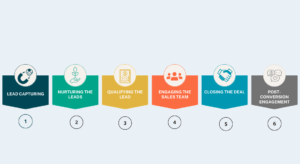In the dynamic world of sales and marketing, lead conversion holds the key to business success – the art of transforming potential customers into loyal clients. Much like nurturing a seed into a blossoming flower, lead conversion demands patience, strategy, and a deep understanding of customer needs. In this article, we embark on an insightful journey, exploring the essential steps that pave the way from curious prospect to delighted customer. Join us as we unravel the secrets behind the lead conversion process and discover how to forge valuable relationships that stand the test of time.
Let’s delve into the world of conversions and witness the magic unfold!
Who are Leads and Why Are They Vital for Business Growth?
A lead, in the context of sales and marketing, is a potential customer who has expressed interest in a product or service offered by a business. Leads can be generated through various means, such as website inquiries, social media interactions, or attending events. They are the initial step in the customer journey, and businesses often nurture leads through targeted communication to eventually convert them into paying customers. Identifying and cultivating leads is crucial for the growth and success of any business, making them a fundamental aspect of the sales process.
The lead conversion journey entails a series of steps that need to be followed:

Step 1:
Lead Capturing
“Your Key to Converting Curiosity into Customers!”
In the bustling world of business, success hinges on capturing potential customers effectively. Lead capturing is the crucial first step in the lead conversion journey. By employing various strategies like web forms, landing pages, and social media, businesses entice prospects to express interest in their products or services. Whether it’s an eye-catching ad or an irresistible offer, a well-executed lead capturing process lays the foundation for a successful conversion journey.
Step 2:
Nurturing the Leads
“Cultivating Strong Connections that Blossom into Loyal Customers!”
Once the seeds of interest are sown, it’s time to nurture the leads. This step involves engaging and building relationships with potential customers through targeted content, personalized emails, and helpful resources. Nurturing is like tending to a garden; consistent attention and care are necessary to cultivate strong and meaningful connections with leads. By understanding their pain points and offering valuable insights, businesses create an environment where leads can blossom into loyal customers.

Step 3:
Qualifying the Lead
“Separating the Diamonds from the Rough”
Not all leads are created equal, and this is where lead qualification comes into play. In this step, businesses analyse leads to determine their potential value and likelihood of conversion. This involves assessing factors such as budget, authority, need, and timeline. By filtering out unqualified leads, sales teams can focus their efforts on those who are more likely to convert, maximizing their efficiency and increasing their chances of success.

Step 4:
Engaging the Sales Team
“How to Supercharge Your Team for Maximum Conversions!”
The sales team takes center stage as they engage with qualified leads to explore their needs and tailor solutions accordingly. This step requires active listening, effective communication, and genuine interest in understanding the customer’s perspective. Building rapport and trust are crucial during this phase as it helps foster a positive relationship between the potential customer and the business. Skilled sales representatives leverage their expertise to present compelling proposals that address the lead’s pain points and position the company as the best choice.
Step 5:
Closing the Deal
“Seal the Deal and Seal the Success”
The culmination of a well-executed lead conversion journey comes with the deal closure. This step involves finalizing the sale, whether it’s a signed contract, a completed purchase, or an agreement to move forward with the business. The art of closing requires finesse and persistence, as sales representatives must overcome objections and secure the lead’s commitment. A successful deal closure marks the transformation of a lead into a satisfied customer, bringing fulfillment to both parties.

Step 6:
Post-Conversion Engagement
“Beyond the Sale: Building Lasting Connections”
The journey doesn’t end with closing the deal; rather, it evolves into a new phase of post-conversion engagement. This step focuses on reinforcing the customer’s decision to choose the business and fostering long-term loyalty. From delivering exceptional customer service to seeking feedback and offering ongoing support, businesses demonstrate their commitment to customer satisfaction. Satisfied customers can become brand advocates, spreading positive word-of-mouth and driving new leads, completing the circle of the lead conversion journey.
Converting a lead is a dynamic and multifaceted process that involves understanding the lead’s needs, nurturing relationships, and providing tailored solutions. At Techmax Technologies, we believe in a customer-centric approach to lead conversion, where we leverage our expertise and innovative solutions to guide leads through the sales funnel successfully. Remember, the journey doesn’t end after conversion; it extends into a long-term relationship with the customer. By focusing on customer satisfaction and post-conversion engagement, businesses can foster loyalty and advocacy, ultimately leading to sustainable growth and success.





